Lab-grown quail? Aussie firm Vow gains approval to sell cultivated quail in S’pore
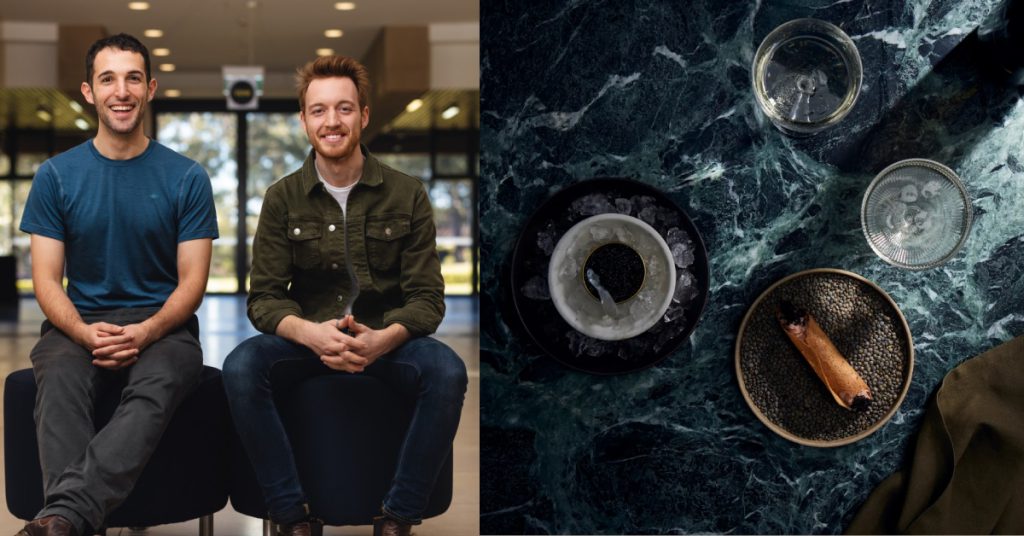
Australian alternative protein company Vow launched its cultivated quail meat, Quailia, yesterday (April 3) in Singapore after receiving regulatory approval from the Singapore Food Agency (SFA).
Under the brand Forged, Quailia is described as an “entirely new cultivated meat” made from the cells of a Japanese quail.
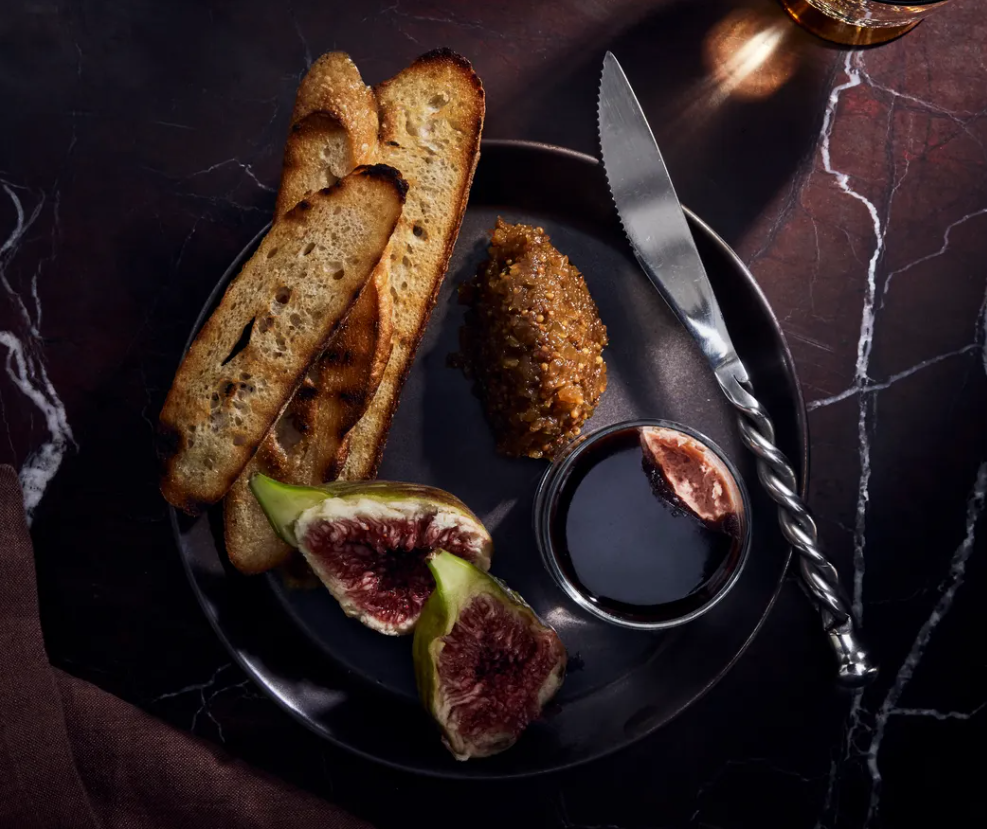
According to an article by The Straits Times, co-founder and CEO George Peppou shared that the company wanted to create a product that was “distinctively different” from meat that consumers are already accustomed to, such as chicken, pork, or beef.
“People have a general vibe of what quail tastes like, but they don’t have a very distinct impression of its taste as they would with other conventional types of meat,” explained Peppou.
He also shared that it took 15 months for the company to receive approval from the SFA for the sale of its cultivated quail as a food ingredient. The license will allow Vow to develop all kinds of quail-derived food products, including whole meat cuts, without further approval from the authorities.
The Forged Parfait will be available to the public for tasting at Mori restaurant from April 12 to 27, as part of a S$289 seven-course omakase menu with alcoholic drink pairings.
According to Forged’s website, the brand will be announcing its first restaurant collaboration in May this year and has plans to launch new flavours down the road.
Doesn’t want to compete in taste with “real meat”
Quailia is currently produced in Sydney, where scientists start by taking a small sample of cells from a Japanese quail species and isolating the cells that contribute to the parfait’s taste and texture.

These cells are then cultured in a bioreactor – a stainless steel tank similar to the ones found in a brewery. To bring out the “gaminess of quail”, ingredients including butter, seasoning and cognac are added to make the parfait.
Unlike many cultivated meat companies, Vow does not intend to replace agricultural-grown meats with their products. In a self-written article, Peppou pointed out the challenges that many of Vow’s predecessors experienced in changing consumer behaviours with their alternative proteins.
You’re not going to change consumer behaviour by offering them something which is a similar enough version of what they already consume.
Externalities like sustainability or animal ethics are not enough for us to change our behaviours for very long, despite what we’d like to believe. This is why plant-based alternatives have plateaued in sales in the past three years; the ethical or moral motivations aren’t reason enough to get meat-eaters to forgo a thing they love, and any alternative is fighting against a lifetime of experience on what chicken is and isn’t.
George Peppou, co-founder and CEO of Vow in a written article on Medium
Over the past few years, the cultivated meat industry has started out with much fanfare. However, many alternative protein companies have plateaued and been unable to achieve commercial success.
A notable case in Singapore would be Shiok Meats, who garnered media attention for their cell-based siew mai and cultivated crustacean products. The food-tech startup has shared that they were unable to scale their production process and experienced high turnover rates as a result.
In March this year, the company merged with another Singapore-based startup, Umani Bioworks (previously known as Umami Meats), to spur regulatory approvals and launch its products into the market.
Despite the industry’s scrutiny, Peppou shared that he has remained confident in the firm’s commercial viability through its “one-of-a-kind” products.
The firm previously raised US$49.2 million in Series A funding in 2022, where the funds will be used to build their second factory facility and bring their products to the market.
Vow was also the mastermind behind the “mammoth meatball,” which went viral last year because it was created using the DNA of the extinct mammoth. While the meatball was not made for consumption, the firm also boldly stated the “potential of cultured meat from many different perspectives.”
Whether it is blind optimism or a new breakthrough in the cultivated meats industry, only time can tell the success of Vow and Forged.
Featured Image Credit: Square Peg Capital, Vow
Also Read: All sizzle, no steak: Cultivated meat has turned out to be a Silicon Valley flop, here’s why
Malaysians in Forbes’ 2024 World’s Billionaires List: Who’s new, who’s missing?

It’s April, and as always, Forbes has dropped its World’s Billionaires List, which is updated and published annually.
17 Malaysians have made the cut this year, with the majority of them being returning names. But we have a couple of new billionaires, as well as a few who are missing from the list.
Across the globe, Forbes reported that there are now more billionaires than ever—2,781 in all, which is 141 more than last year. They also reported that these billionaires are richer than ever, worth US$14.2 trillion in total.
In Malaysia, though, it seems like the richest few have lowered net worths compared to last year, possibly because of the exchange rate.
In any case, here are the Malaysian billionaires highlighted by Forbes’ list this year.
The frequenters
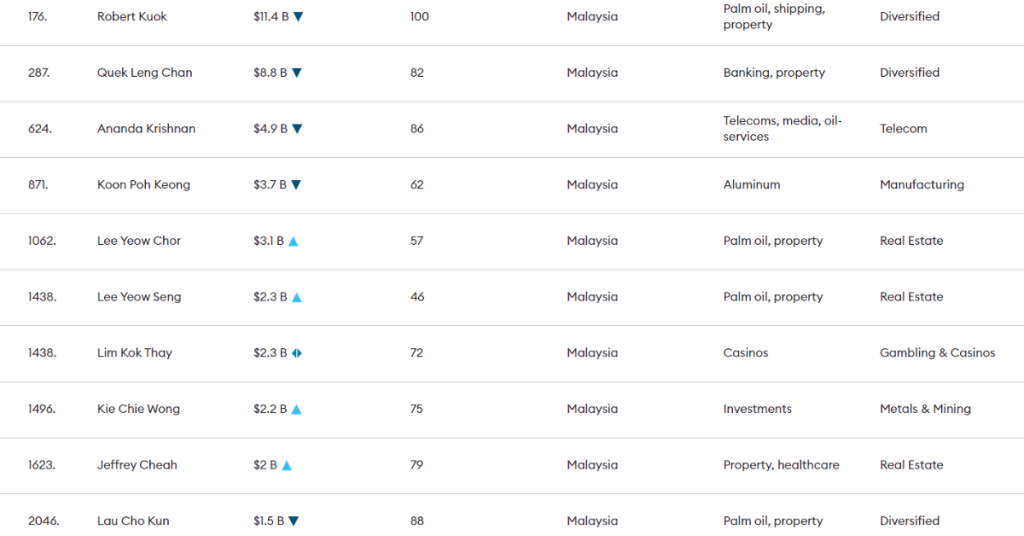
No introductions needed, Robert Kuok (who turned 100 last October!) tops the chart once again with a net worth of US$11.4 billion, which is a dip from last year’s US$11.8 billion. Last year, he had been 146th richest in the world, but that has dropped to 176th this year.
The second Malaysian on the list is Quek Leng Chan, the 287th richest man in the world. With a net worth of US$.8.8 billion, the 82-year-old is the executive chairman of Hong Leong Co. (Malaysia).
Third is Ananda Krishnan, whose net worth is US$4.9 billion, a drop from last year’s US$5.2 billion. He got his wealth from a diverse portfolio of holdings.
The 871st richest billionaire in the world is Koon Poh Keong with a net worth of US$3.7 billion. He is the group CEO of aluminium company Press Metal.
Next up is Lee Yeow Chor, who has grown his net worth from last year, going from US$2.8 billion to US$3.1 billion. You’ll know him as one of two inheritors of stakes from IOI Group, which was built by his father.
His brother Lee Yeow Seng follows him on the list, his net worth having grown from US$1.6 billion to US$2.3 billion.
Also having a US$2.3 billion net worth is 72-year-old Lim Kok Thay, the chairman of Genting. He has maintained his net worth from last year.
Kie Chie Wong, who debuted on the list in 2022, is number 1,496. Forbes reported that he gets the bulk of his wealth from a minority stake in Fortescue Metals Group. His net worth has increased from US$1.8 billion to US$2.2 billion.
Jeffrey Cheah, the man behind the Sunway empire is next, with a net worth of US$2 billion, a jump from 2023’s US$1.2 billion.
The largest shareholder in Hap Seng Consolidated, Lau Cho Kun, makes the list at number 2,046 with a net worth of US$1.5 billion. The company’s focus is in palm oil and property.
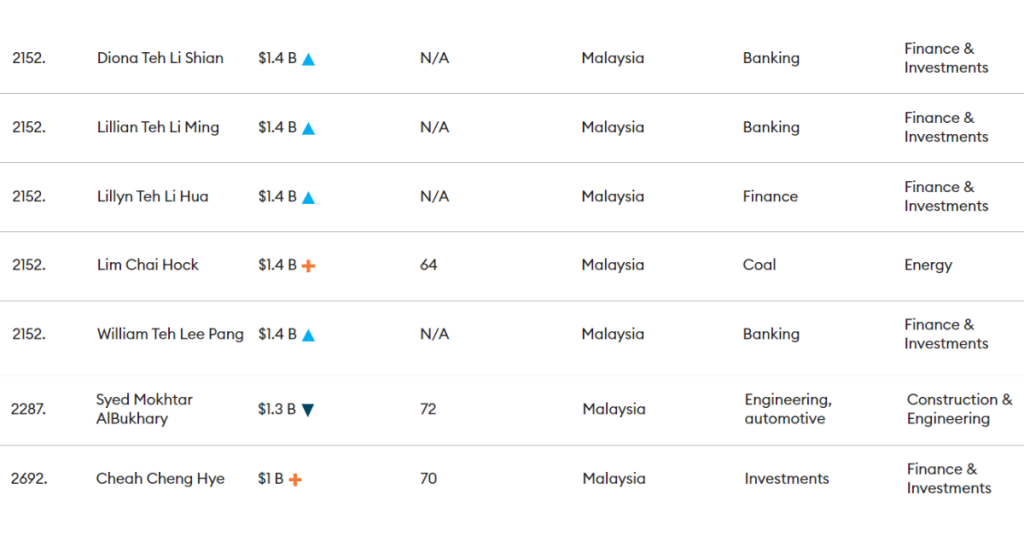
At joint 2,152nd place are siblings Diona Teh Li Shian, Lillian Teh Li Ming, Lillyn Teh Li Hua, and William Teh Lee Pang. The three sisters became the first female Malaysians to be billionaires last year, after the passing of their father, Teh Hong Piow, who chaired Public Bank for decades. They have a net worth of US$1.4 billion.
At number 2,287 is Syed Mokhtar Al-Bukhary. With a net worth of US$1.3 billion, the 72-year-old started as a rice trader after dropping out of high school.
The newbies

We have two new Malaysian billionaires on the list this year.
The first is Lim Chai Hock, the COO and director of Bayan Resources, which is the third-largest coal producer in Indonesia. Now 64 years old, Lim had cofounded the Bayan Group, and also sits on the board of a few subsidiaries.
According to Forbes, prior to joining Bayan Group, he worked as a site manager with Jaya Sumpiles Indonesia, which is a coal mining infrastructure company.
He has a Malaysian citizenship, Forbes reported, but resides in Jakarta, Indonesia.
Cheah Cheng Hye makes his debut on the list at number 2,692, making him the last Malaysian billionaire on the list this year.
A fund manager, Cheah Cheng Hye is the co-chairman and co-chief investment officer of Value Partners Group.
The 70-year-old had cofounded the asset management company in 1993, and listed it in 2007 in Hong Kong where he resides.
Forbes reported that Cheah graduated from Penang Free School and had a stint working as a subeditor and writer at The Star newspaper in Malaysia.
The absentees
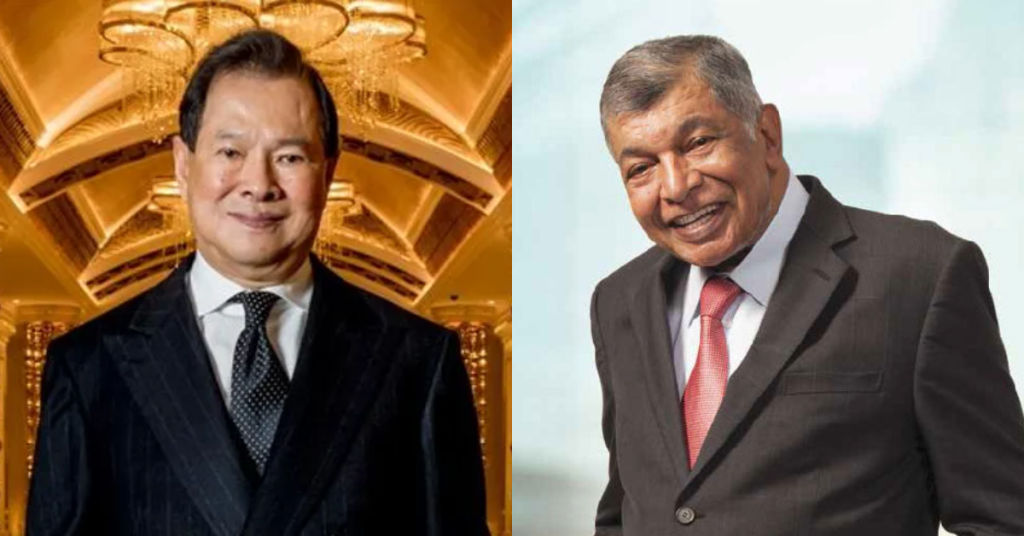
Missing from the list this year are three Malaysians. Namely, they are Chen Lip Keong, G. Gnanalingam, and Tan Yu Yeh.
Chen Lip Keong, the Malaysian businessman behind NagaWorld (a casino company in Cambodia), passed away on December 8, 2023 at age 76.
He had graduated as a medical doctor but opted for a career in business, Forbes reported. Picking up his legacy is his son, Chen Yiy Fon, who was appointed as the group CEO.
G. Gnanalingam was the executive chairman of Westports Malaysia Sdn Bhd, one of Malaysia’s leading port operators. He was born in Japanese-occupied Singapore and grew up in Port Dickson and Kuala Pilah. He passed away in July 2023 at 78 years old.
According to Forbes, his son Ruben Emir Gnanalingam is now Westports’ group managing director.
Tan Yu Yeh is the founder of Mr. D.I.Y, our homegrown home improvement retail chain. He had debuted on the list in 2021 with a net worth of US$1.8 billion, but it dipped to US$1.1 billion last year. He did not make it onto the list this year.
- Learn more about Forbes’ World’s Billionaires List here.
- Read other articles we’ve written about Forbes’ lists here.
Also Read: Why M’sians need to join this 2-day event in PJ that’ll boost your understanding of IPs
Featured Image Credit: Bayan Resources / Sunway Group / Hong Kong Financial Services Development Council
At 19, this M’sian started a shoe painting biz that’s since grown into a physical art studio
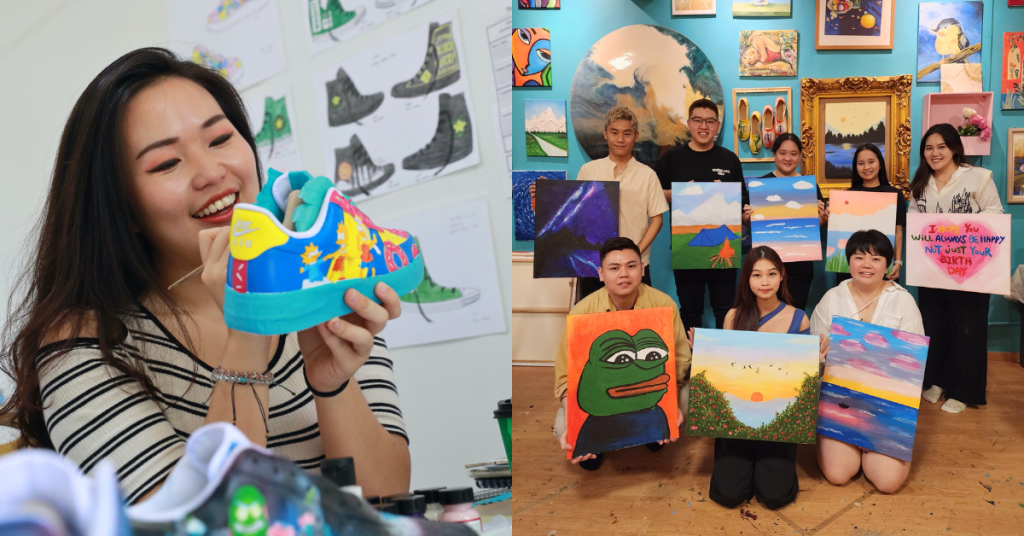
A career in the arts wasn’t exactly what Maggie Tan’s mum had envisioned for her. She would tell Maggie, “Art cannot feed you.”
So Maggie chose to study a business degree instead, something that’s more practical, and thought that was the end of it.
But a simple birthday gift led her back to her true passion.
Having a knack for painting, Maggie forwent purchasing a present and used her talents instead. She got a pair of shoes in her friend’s size and decorated it with her artwork. Proud of her handicraft, she posted it on Facebook and immediately began receiving enquiries about them.
“At that moment I realised, ‘Oh hey, so people are actually paying me to paint shoes?’” she recalled. This was back in 2010 when commissioned art wasn’t really popular in Malaysia, but she decided to give it a shot.
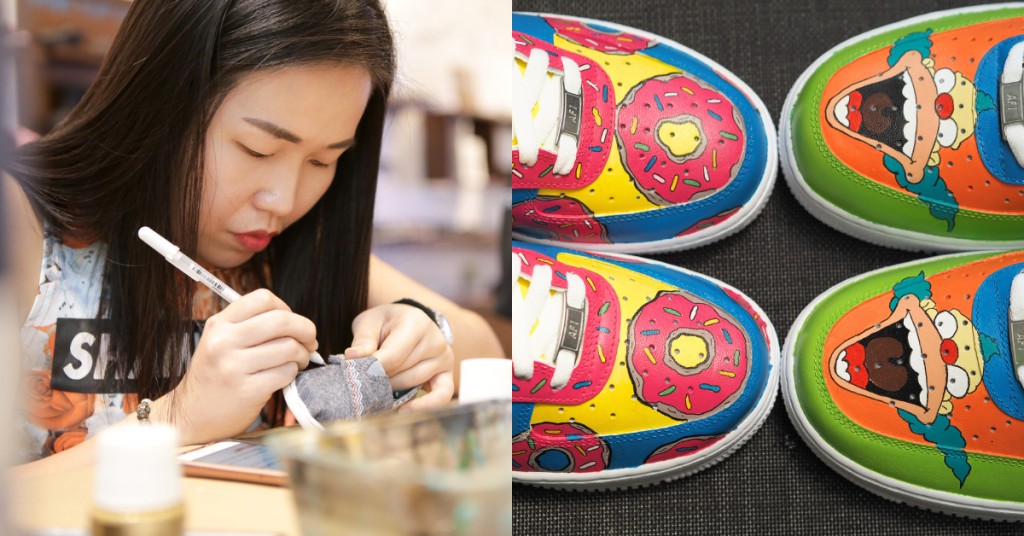
This marked the start of her artistic journey which paved the way to the opening of her own brick-and-mortar art studio called MTMT Studios, a creative art playground for the young and old.
Let’s backtrack for a second
If you’re a millennial or older zoomer, you probably took part in the sneaker art trend that boomed in the 2010s. Or at the very least, you’re likely aware of it.
Artists around the globe would paint wearable artwork on sneakers to much fanfare. This could be as simple as adding more colours to make it unique, to replicating the likeness of favourite cartoon characters.

During the middle of her career as a sneaker artist, Maggie’s more recognised works fell under the latter category. This included Spongebob Squarepants, the Simpsons family, and Rick and Morty designs.
Initially, she painted on Malaysian school shoes like Bata. But when clients were willing to spend more, she moved on to higher-end shoes such as Vans and the trendy Nike Air Forces.
Most of her sales came from the internet where she would post on social media and Etsy, a creative entrepreneurship platform. This led her business to go international where many of her customers hailed from the US, UK, Australia, and even Bosnia.
“It felt surreal to earn in a foreign currency back then, especially while in university because I haven’t even gotten my starting pay working full time for a company,” she recalled.
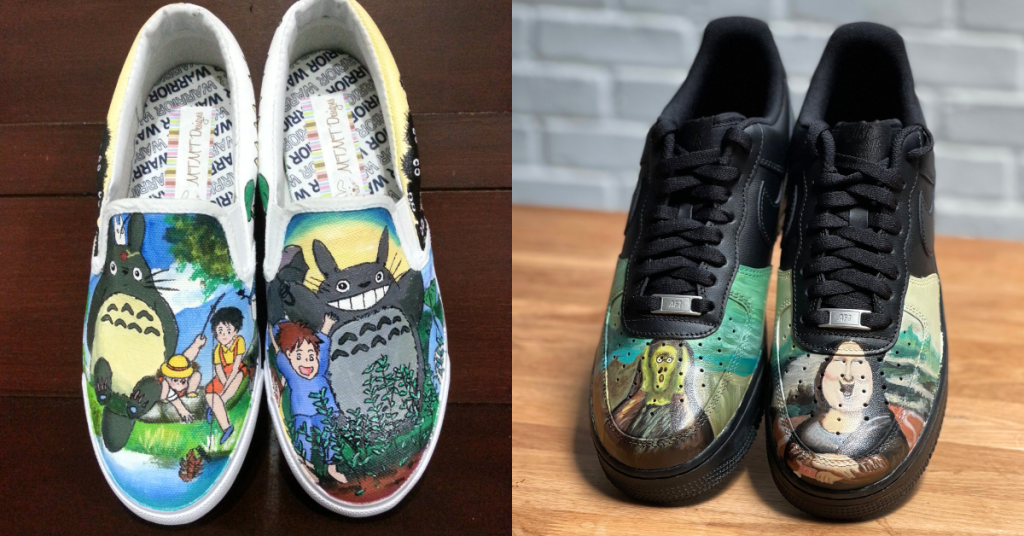
Paving a path for herself
Upon graduating, she started her career by dipping her toes in different industries. Whether that be banking, insurance, fashion, or even personal development, she persisted relentlessly to find her place in the corporate jungle.
But as time went on, she didn’t feel like she belonged in any of them. Couple that with some unpleasant experiences with corporate bullies and you can see why she wanted to leave.
“Don’t get me wrong, [the] pay was great, but my sense of purpose was empty. I had this epiphany moment thinking if I were to die then, it felt like I wasn’t even leaving any form of legacy. So why work so hard for someone’s company when they don’t even value you?” Maggie explained.
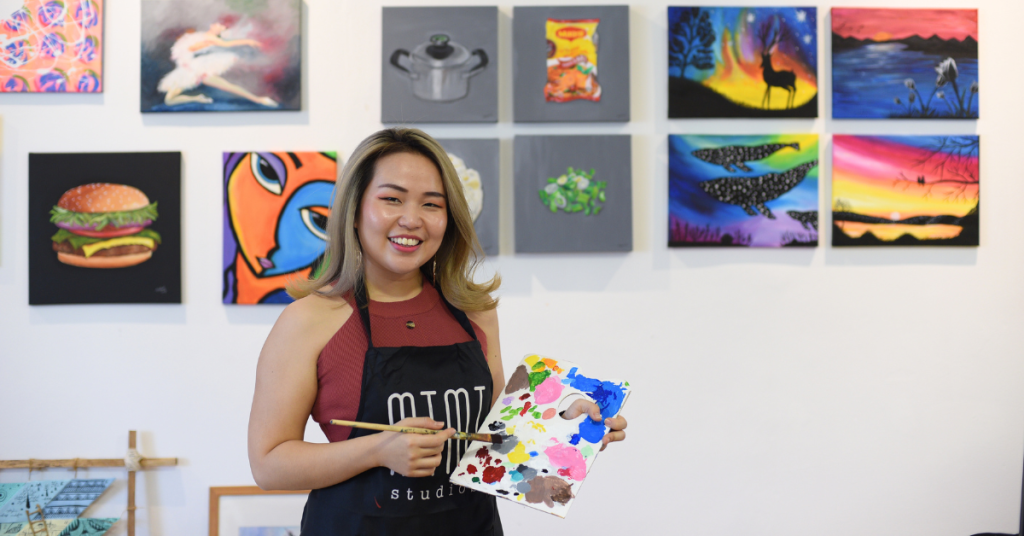
Having had enough, she decided to quit corporate life for good. Coincidentally, her mum wanted to downsize her beauty salon as well, which freed up a large space perfect for MTMT Studios. So that’s exactly what she turned it into.
It was quite a gamble as the art industry was (and still is) underappreciated in Malaysia. However, Maggie utilised the resources she could find.
This came in the form of the National Art Gallery’s Young Art Entrepreneur (YAE) programme. A four-month programme, it helps artists build their entrepreneurial skills while enhancing their creativity.
“YAE opened doors to a lot of opportunities and I’m beyond grateful up till now that this platform allowed so much magic to happen,” Maggie stated.
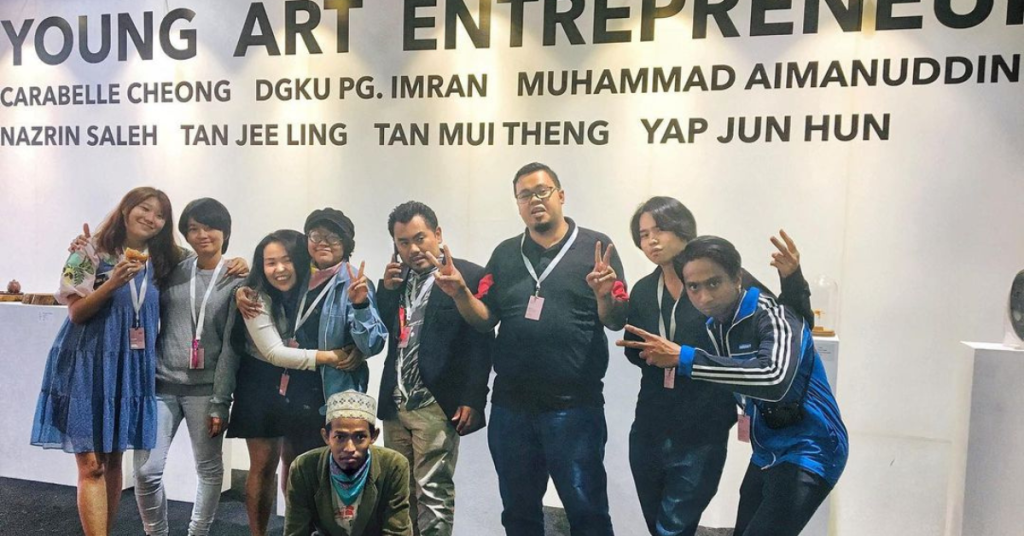
Being flexible & adapting to changes
Her original intention for MTMT Studios was to have a place to grow her shoe painting business. It was meant to be a space to work on her creations while doubling as a workshop area for people to try the crafts themselves.
Much to her disappointment, it wasn’t well received.
People didn’t want to wear something they painted, nor did they want to ruin their own footwear. It wasn’t practical for Maggie to supply the shoes either as that would mean stocking up on various sizes.
So she pivoted and turned MTMT Studio into an art jam facility that hosted various art workshops.
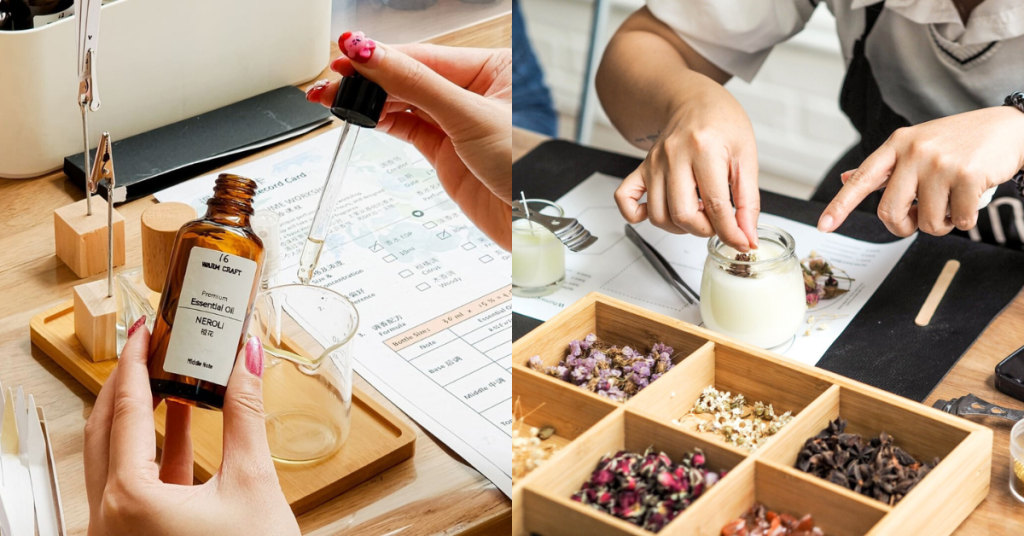
Amongst those were canvas painting, pottery, perfumery, candle making, and embroidery, where she’d invite artist collaborators to teach their niche. Business was booming at some point, where they’d be fully booked for days.
However, as time passed, signups began dwindling and became inconsistent. Knowing this couldn’t go on, Maggie shifted the business’s focus once again.
Not just a studio, but a community space
MTMT now mainly offers adult painting classes and kids’ art classes. Adult classes include intuitive painting sessions, as well as textured and non-textured artworks. The starting price is RM95 and can go up to RM1,200.
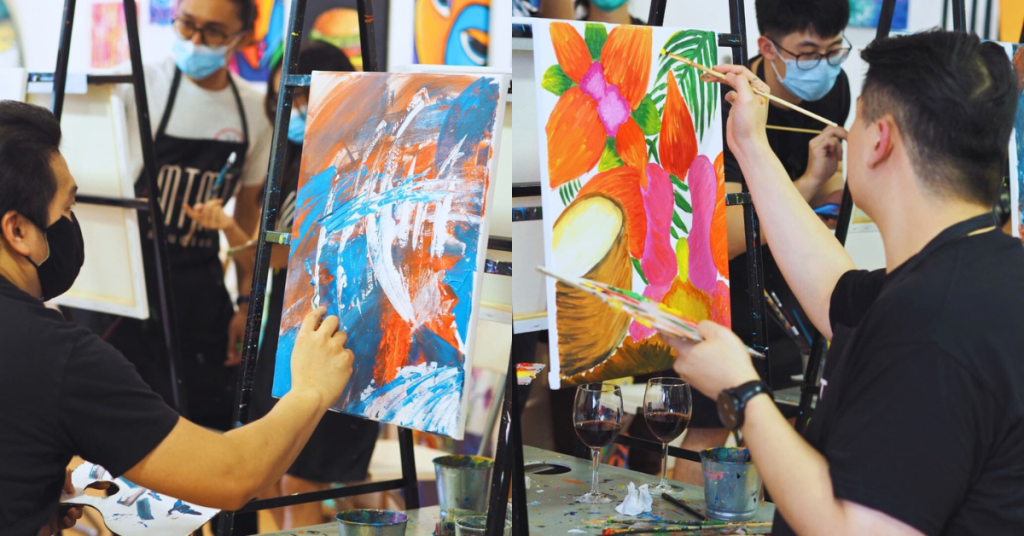
On the other hand, sessions for children include one-off lessons for painting and crafts, along with an annual arts programme. The latter divides students according to age groups:
- 4 to 6 years old
- 7 to 12 years old
- 13 to 17 years old
Each age group has different syllabuses taught by partnering artists and explores different stages of art skills. For example, lessons for kids below the age of six revolve around sensory play, while classes for teens are meant to enhance discipline and creative expression.
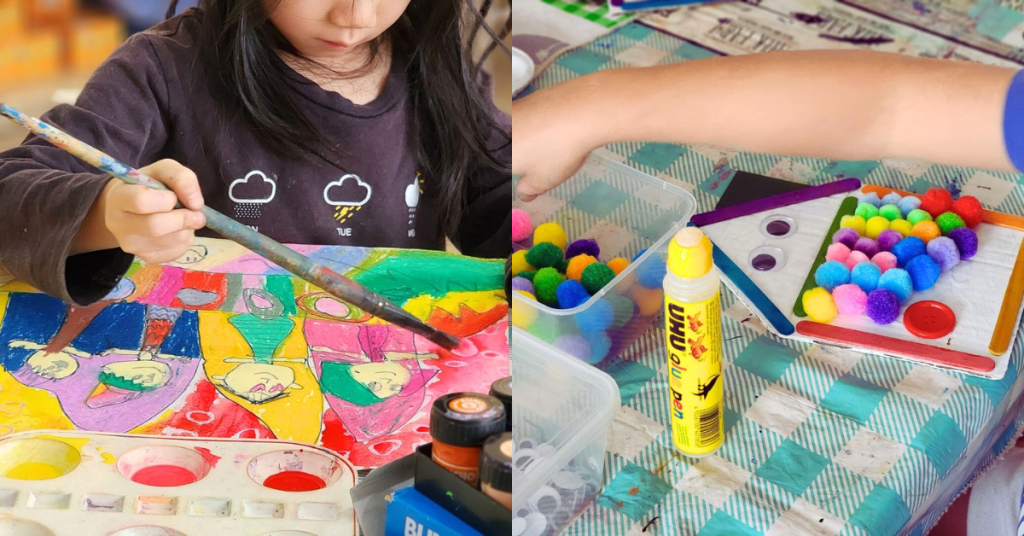
The full price for this isn’t stated on the website, but there is a trial session for RM50.
Maggie assured us that all of MTMT Studios’ classes are beginner-friendly. Those with zero background in art are highly welcomed alongside more advanced students.
The business focus shift was quite recent, and the studio is still going through a transitional phase. She hopes this will improve the state of the brand’s finances and make them more stable.
On a more personal note, her vision for MTMT Studios remains the same—to make it a communal art space where you’re not just picking up skills, but friendships too.
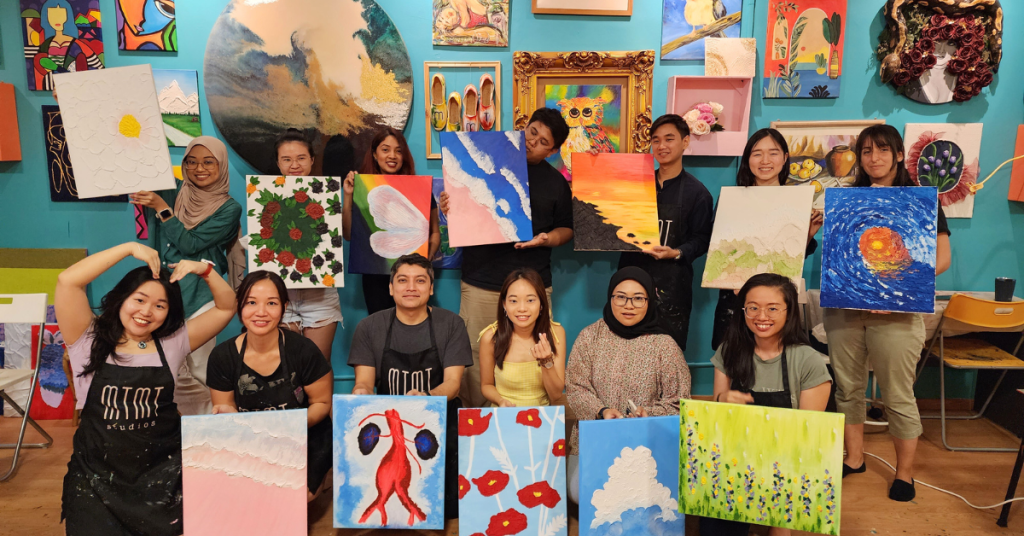
- Learn more about MTMT Studios here.
- Read other articles we’ve written about Malaysian startups here.
Also Read: Employees need a Copilot to boost productivity & ease brain drain. This webinar shows how.
Featured Image Credit: MTMT Studios
These M’sian men started a fashion house turning old clothes into one-of-a-kind bags
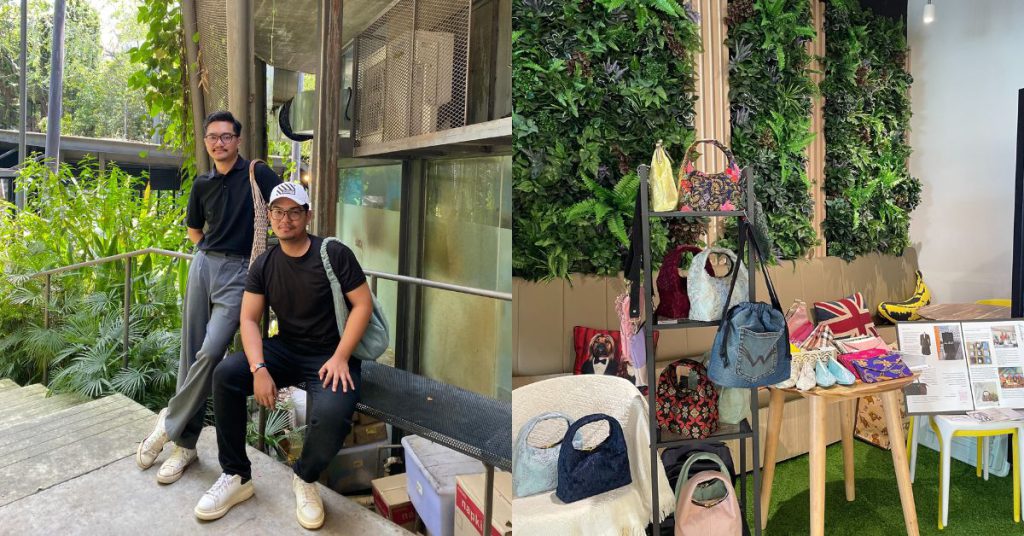
Ever wondered what to do with the old clothes pile that you have been hoarding? Well, this duo has been recycling used clothes to create unique and stunning bags for the past four years.
Abdul Muhaimin Abdul Hadi, 29, and Muhammad Harrith Hasmadi, 27 are the masterminds behind Hashadi, a local designer brand making waves by transforming used clothes into unique and stunning handbags and bags for women.
According to FMT, the brand name Hashadi is a portmanteau of their fathers’ names.
Hashadi’s journey began amidst the challenges of the COVID-19 pandemic. With job opportunities scarce, Abdul Muhaimin (Min), armed with a degree in Fashion Design, and Harrith, pursuing a degree in Teaching English as a Second Language, saw an opportunity to repurpose old clothes.
What started as a way to earn pocket money and hone their skills became a thriving business.
“In early 2020, when the pandemic hit, we had time on our hands. Harrith suggested turning his old clothes into tote bags. Skeptical at first, I agreed to give it a try,” Min recalled.
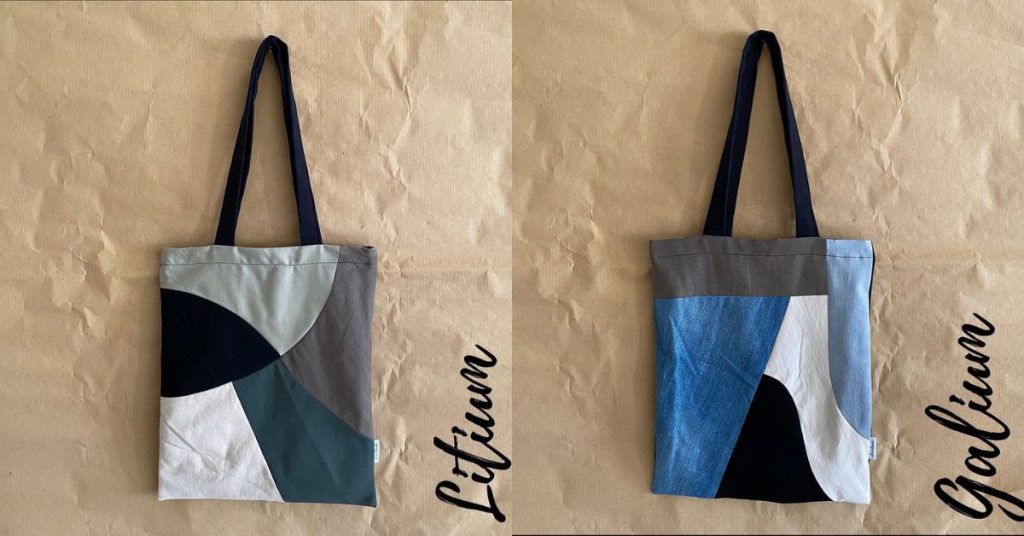
Thus, Hashadi was born, with an Instagram account showcasing their creations.
After posting pictures of their first creation, tote bags, they received a lot of positive feedback from their friends and family who encouraged them to produce more bags.
Sewing their way through challenges
Their journey wasn’t without challenges. Neither had prior business experience, but they learnt on the fly, from time management to customer service.
“Each bag took hours to make, but positive feedback kept us going,” the co-founders added.
They also noted that many things have changed since they first launched their product.
“We used to create bags that are different for each design in every collection which surely takes us much time and effort,” they said.
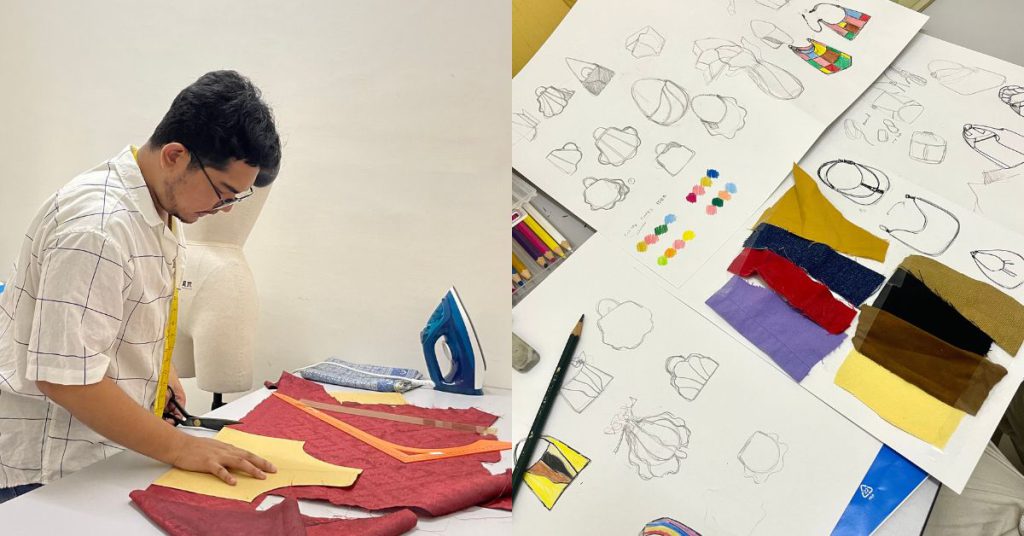
Now they are focusing more on creating commercial bags whereby the design is standardised for each collection to optimise time and cost. However, these designs still stand out with the use of different fabrics.
In the early days, they also struggled to be consistent in creating products as they lived far away from each other.
“It’s hard for us to discuss and communicate about the business. But with technology nowadays, we can Facetime or video call, which helps us in many ways where we can have a meeting virtually anytime convenient for both parties,” they said.
From wedding remnants to fashion statements
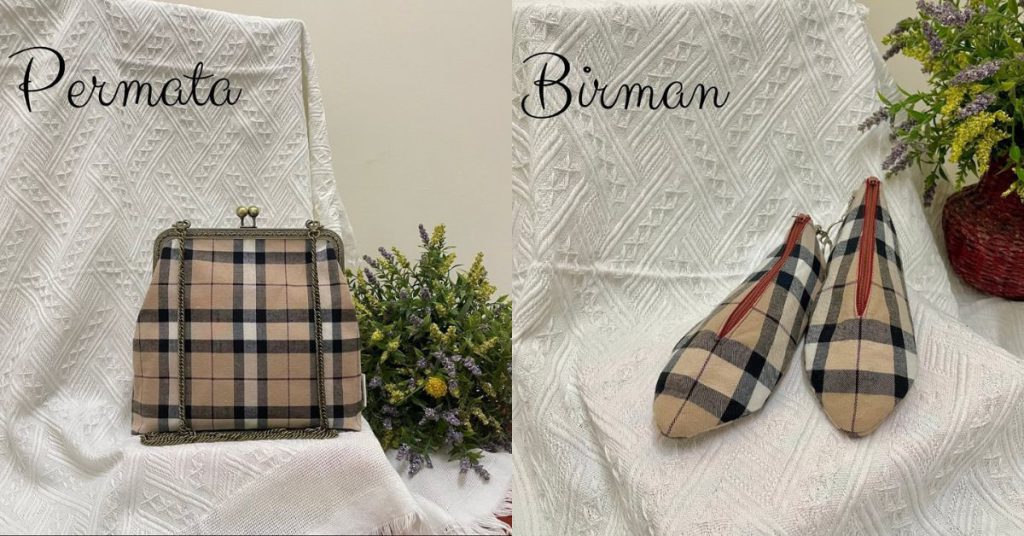
Initially sourcing materials from friends, family, and thrift stores, Hashadi now collaborates with a bridal boutique in Penang, utilising fabric remnants to create one-of-a-kind bags.
“All the remnants from making wedding dresses vary from lace, satin, and songket. Normally, each fabric remnant can make up for only one bag. However, depending on the size of the remnant, we would produce more than one bag upon request,” they said.
They shared that the average time spent for each bag could vary from two to seven hours from start to finish depending on the size and complexity of the design.
“Usually, we release at least one collection per month offering six to 12 bags with different colours and designs depending on the materials that we have at the moment.”
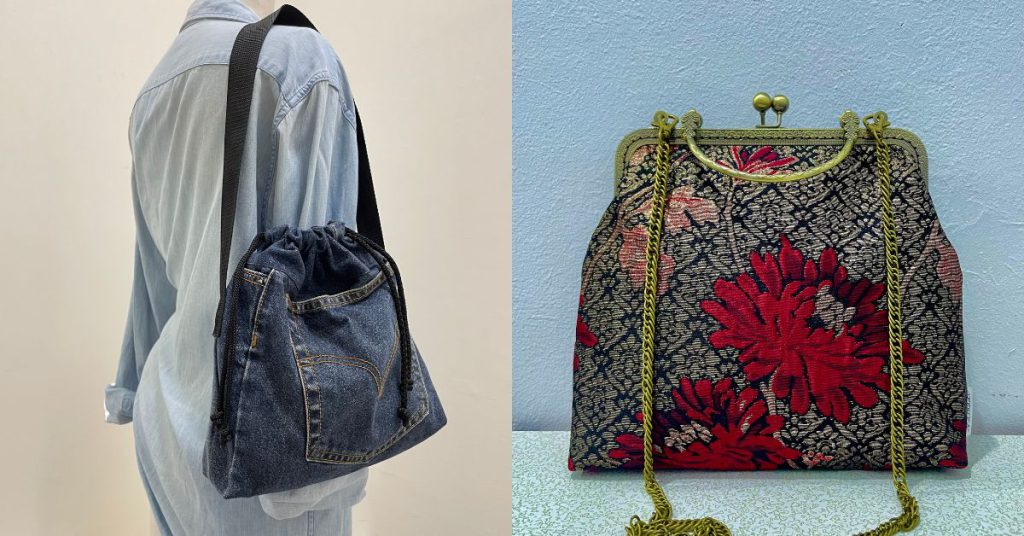
Hashadi now also offers a variety of collections including elegant clutches, crossbody bags, shoulder bags, and envelope purses all made from old fabric including denim and lace.
Thus far, their designs, inspired by social media and Malaysian culture, resonate with a diverse customer base.
“We’re proud to incorporate traditional fabrics like songket, batik, and saree into our designs. It’s our way of celebrating Malaysian heritage,” they explained.
However, they can only produce limited quantities at the moment as they are still a two-man show, with no immediate plans of expanding.
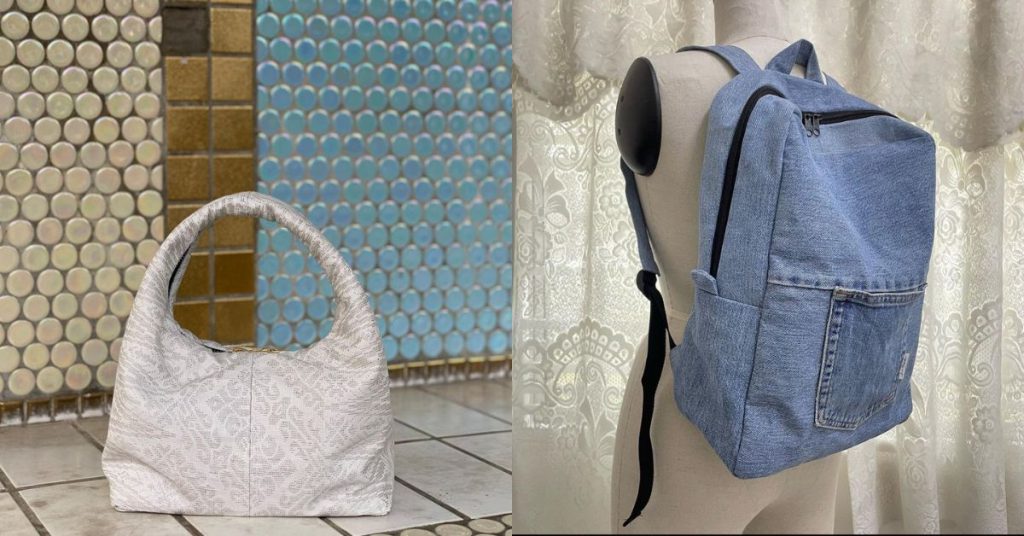
On their way to making it
Despite geographical challenges—with Min managing operations while Harrith pursues a full-time career—Hashadi continues to thrive.
Collaborations with local designers and appearances at pop-up events have expanded their reach.
One of their proudest moments was selling their first collaborative bags offline at a pop-up booth in The Godown Art Centre, Kuala Lumpur, on July 2023.
One thing led to another, and on December 2023, Hashadi once again joined a pop-up booth at Karnival Merakyatkan Seni Akademi Seni Budaya Dan Warisan Kebangsaan at Sports Arena, Kuala Lumpur.
“It was special to see our creations resonate with customers,” they recalled.
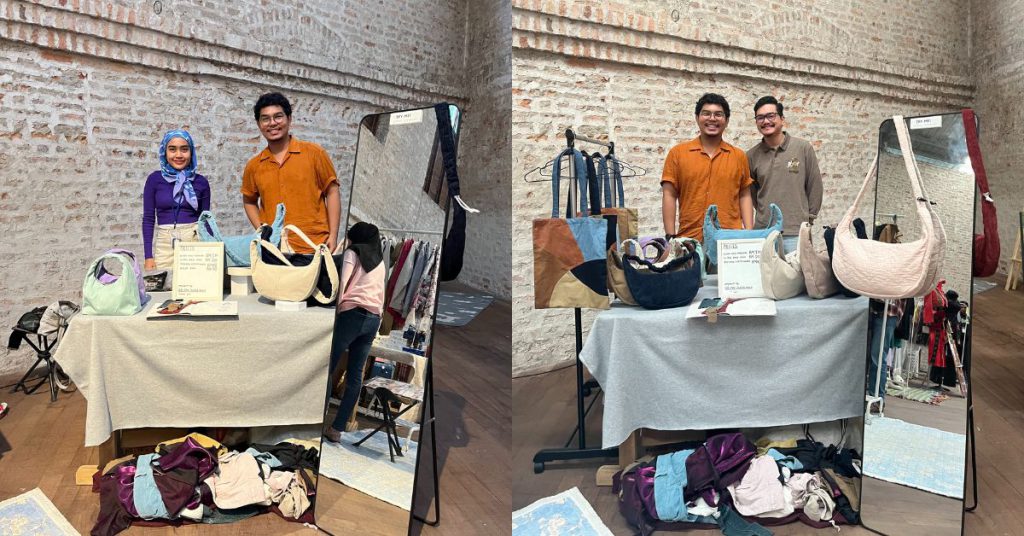
Reflecting on their journey which started four years ago, they emphasised the importance of persistence.
“Starting a business is one thing, but maintaining relevance is another. It takes effort and patience,” the co-founders said.
Their dedication hasn’t gone unnoticed. Hashadi’s appearance on national television was a milestone moment, showcasing their journey to a wider audience.
As they continue to turn old clothes into fashion statements, Min and Harrith dream of scaling up Hashadi into a full-time venture, catering to both men and women.
- You can learn more about their business here.
- Read other articles we’ve written about Malaysian startups here.
Also Read: Employees need a Copilot to boost productivity & ease brain drain. This webinar shows how.
Featured Image Credit: Hashadi